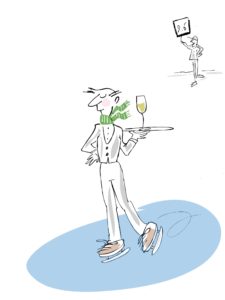
I remember back in the 1980’s reading the late Marcella Hazan’s first cookbook and being taken aback by her confiding that the secret ingredient of all savvy cooks is . . . water.
She went on to explain how either adding a bit or removing a bit (by simmering) would balance a sauce or bring it to the right consistency. It was a lesson I’ve made good use of since.
My guess is that many people would be surprised to learn that water is also a secret ingredient in winemaking.
Wine is, after all, typically 85% water, and while it’s the grape sugars that make fermentation by yeasts possible, it’s the ratio of water to the flavor and aromatic compounds that largely determines the quality, character, drinkability and even durability of wine.
It’s one of the reasons that European wine law specifies an upper limit to how much juice can be taken from a single hectare (2.5 acres) of vines and still qualify for an appellation designation.
Allowing for variations in planting density, the rule of thumb is that the higher the per-hectare yield of juice, the more dilute (less flavorful and aromatically interesting) the resulting wine is likely to be.
But wine can sin with both the left and right hand. Wine made with very ripe or overripe fruit will have less water and, while more concentrated, the resulting wine may have correspondingly less to offer in the way of refreshment and gastronomic compatibility.
One question that has always piqued my interest, goes something like this: If winemakers can freely fiddle with the water content of their wine, why can’t I, you, everybody?
It’s an issue I’m more likely to be contemplating in the heat of summer, when certain wines — either because of the occasion, the time of day, the temperature, or the menu — don’t seem quite right coming straight from the bottle. Today, the notion of adding a few drops of water to adjust the wine to the circumstances is considered distinctly declassé – scandalous, even — though it wasn’t always so.
For most of wine’s history, adjusting it with water was considered the only civilized way to drink. It was Dionysus, the story goes, who first taught humans to mix wine and water in rational proportions. Taking wine ‘neat’ was a barbarian habit, not something civilized people engaged in. Indeed, adjusting wine to the occasion has an impeccable historical pedigree, and there’s no reason to refrain from playing wine god if you think the situation warrants it.
For most of us, the closest we come to permitting ourselves to participate in this historic practice is the moment we contemplate adding an ice cube to our glass of wine. So, what about it? Is ice in your wine ever a good idea? It can be.
Putting your wine in contact with ice is going to have three effects. It will drop the wine’s temperature; dilute it somewhat, and lower the concentration of alcohol. So, think like a winemaker and begin by determining what you want to achieve and how not to overshoot the mark.
The surest way for things to get quickly and irrevocably out of hand is to put ice in your glass and then pour wine in after it. Do this and your wine will almost immediately become too cold and, as the ice melts, progressively less wine-like.
My preferred way of going about this is to place a cube or two in a smallish stainless funnel and position it over a glass. Pour a few ounces of wine over the ice so that it drains into the glass immediately. The wine will only be in contact with the ice for the briefest moment.
You should now find the temperature comfortably cool, the wine pleasantly fresh and a bit lighter on its feet. You’ve put all three effects into play, but in a completely controlled way, one serving at a time.
This pour-over technique works for white, orange, pink and light-bodied, low-tannin red wines. Variables are the size of the cube, the number of them, and how quickly or deliberately you pour. I use just one large 3″ cube, but you could use the more common, smaller, elongated ones. For denser-bodied, higher tannin reds you’ll want to skip the ice and just drizzle a bit of cool water into the glass. It takes very little to have a good effect.
When ready for a second glass, just repeat with the same cube, if you’re using one. As the ice in the funnel diminishes in size over several rounds, either add a cube or slow the pour a bit. Experiment.
It’s actually hard to go wrong with this approach, since, if you find that the wine has become a bit too light or too cool for your taste, you can always add a bit back from the bottle to get it where you like.
And if anyone objects, just say Dionysus himself said it was perfectly fine.